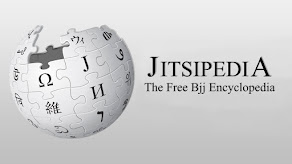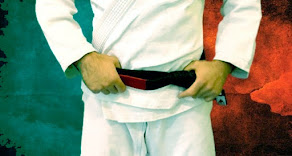"Incoraggiare la creatività: Una delle
cose più difficili per un allenatore è il bilanciamento tra la
necessità di imporre una direzione e una visione su un programma di
allenamento, e allo stesso tempo, dare spazio alla creatività
individuale e allo stile degli atleti.
Troppo spesso vedo programmi che
sfornano una squadra di cloni fatti con lo stampino del loro sensei.
Insegnano tutti lo stesso approccio nonostante le differenze enormi
di corporatura e psicologia dei loro allievi.
Il risultato spiacevole è soffocare l'individualismo e l'espressione
di sé. Un elemento interessante dei tre grapplers più noti che
alleno [Gary Tonnon, Eddie Cummings, Gordon Ryan ndr ] è il fatto
che condividono la mia visione - un gioco incessante di controllo che
porta alla sottomissione, ma hanno modi molto diversi di esprimerla.
Ciò è dovuto al fatto che io insegno una vasta gamma di mosse, tra
cui un gran numero che non fanno parte del mio gioco. Permetto agli
studenti avanzati di selezionare e scegliere da soli. Nel corso del
tempo, il loro gioco unico comincerà a cristallizzarsi e a prendere
forma.
Ho una visione generale dello sport -
se alla gente piace, verranno da me per imparare, altrimenti, se ne
andranno altrove, dove si insegna una visione diversa. Una volta che
comincio ad insegnare loro un livello avanzato, la maggior parte
dell'enfasi è nell'indurli a esprimere loro stessi nel momento in
cui condivido la mia visione generale.
Si consideri questa analogia: due
generali desiderano che loro uomini prendano una certa collina che è
occupata da forze nemiche. Essi condividono un obiettivo comune -
entrambi vogliono prendere la collina. Il primo generale utilizza un
sistema di micro gestione. Ai suoi soldati sono date istruzioni
minuto per minuto da cui non sono autorizzati a deviare. Se si
imbattono in qualche resistenza devono comunicarlo via radio per
nuove istruzioni. Se vedono opportunità spontanee per il successo,
non possono prenderle, ma devono seguire gli ordini iniziali alla
lettera. In altre parole, il primo generale determina non solo il
fine della missione, ma anche tutti i mezzi per quel tal fine.
Il secondo generale specifica solo il
fine della missione - prendere la collina - ma non specifica i mezzi
con cui raggiungere il fine. Invece, egli dà la responsabilità ai
giovani ufficiali di prendere decisioni individuali in base alla loro
crescente conoscenza ed esperienza, in modo che se si imbattono in
problemi o vedono opportunità inaspettate, possono reagire
immediatamente.
Uno sarà un esercito gestito in
maniera micro che sarà solo buono come il generale che li conduce.
Il secondo sarà una vera e propria squadra con una flessibilità,
spontaneità e l'individualità che il primo non avrà mai.
E' mia opinione che il secondo metodo
centrato sul fine produce risultati migliori rispetto a un metodo
eccessivamente rigido dei fini e mezzi . Allo stesso tempo, è
migliore per gli atleti come persone e, in effetti, per lo sport
complessivamente".
John Danaher da poco tempo ha
incominciato a condividere, con tutti, i suoi scritti sulla sua pagina
facebook. Quando si tratta di pensieri molto brillanti e profondi su diversi
aspetti filosofici inerenti il combattimento di
sottomissione il sig. Danaher è la persona da ascoltare molto attentamente. Mai nei suoi scritti frasi banali, ma concetti profondi
sui quali riflettere.
Di solito non risponde mai ai commenti
dei suoi post ma questa volta ha fatto un'eccezione col sottoscritto.
Come Danaher ho un interesse per la storia militare e la sua analogia mi ha ricordato il diverso
approccio tattico che durante la seconda guerra mondiale avevano gli
ufficiali della Wehrmacht e quelli dell'Armata Rossa.
Questo il mio commento:
"Mr Danaher la sua analogia militare mi
ricorda la differenza, e l'approccio opposto, che la Wehrmacht e
l'Armata Rossa ebbero durante la seconda guerra mondiale. Mentre gli
ufficiali della Wehrmacht ricevevano solo ordini di missione, gli
ufficiali dell'Armata Rossa erano obbligati a seguire scrupolosamente
i loro ordini così non potevano adattarsi alle circostanze casuali".
Questa la risposta di John Danaher:
"Questo è corretto i sovietici
migliorarono in questo senso nel proseguo della guerra, ma non hanno
mai avuto la libertà di operazioni che i giovani ufficiali tedeschi
ebbero. È interessante notare che, nemmeno le unità americane o
inglesi ebbero questa libertà. Dopo la guerra numerosi studi hanno
suggerito la superiorità del sistema tedesco che è diventato da
allora lo standard tra gli eserciti occidentali".
Sono rimasto sorpreso e soddisfatto nel vedere che il sig. Danaher ha trovato interessante il mio commento tanto da spingerlo a rispondere. Credo fermamente che la comunità delle arti marziali abbia bisogno sempre più di "pensatori pratici", come il sig. Danaher, che aiutino a formare non solo il nostro corpo, ma anche le nostre menti. Grazie Sig. Danhaer di condividere con noi i suoi pensieri.
"Encouraging creativity: One of the hardest things for a coach to master
is the balancing of the need to impose a direction and vision upon a
training program, while at the same time, giving room for individual
creativity and style to the athletes.
Too often I see programs that churn out a team of cookie cutter clones of their sensei. They are all taught the same approach despite massive differences in body type and psychology.
The unfortunate result is a stifling of individualism and self expression. An interesting element of the three most well known grapplers that I coach is that they share my vision - a relentless game of control leading to submission, but have very different ways of expressing it. This is due to the fact that I teach a very wide array of moves, including a great many that are not part of my own game. I allow advanced students to pick and choose on their own. Over time, their own unique game will begin to crystallize and take shape.
I have a general vision of the sport - if people like it, they will come to me to learn, if not, they will go elsewhere, where a different vision is taught. Once I begin teaching them at advanced level, most of the emphasis is upon getting them to express themselves as they express my general vision.
Consider an analogy: two generals wish their men to take a certain hill that is occupied by enemy forces. They share a common goal - they both want to take the hill. The first general uses a system of micro management. His soldiers are given minute by minute instructions from which they are not allowed to deviate. If they run into expected resistance at certain points, they must radio back for new instructions. If they see spontaneous opportunities for success, they cannot take them, but must follow the initial orders to the letter. In other words, the first general dictates not only the end of the mission, but also the all the means to that end.
The second general only specifies the end of the mission - take the hill - but does not specify the means by which they do so. Instead, he gives responsibility to the junior officers to make individual decisions based upon their growing knowledge and experience, so that if they run into problems or see unexpected opportunities, they can immediately react to them.
One will be a micro managed army that is only as good as the general who leads them. The second will be a genuine team with a flexibility, spontaneity and individuality that the first will never know.
It is my contention that the second end-centered method produces better results than overly strict means and ends methods. At the same time, it is better for the athletes as people and indeed, the sport overall. Here I work on fine tuning to the game of Garry Tonon, one of the most free spirited and unique athletes I ever had the pleasure of training."
John Danaher recently began to share with everyone his writings on his facebook page. When It comes to very bright and deep thoughts on different philosophical aspects regarding the submission fighting Mr. Danaher is the man to listen very carefully: no banal phrases in his writings but profound concepts on which to reflect.
Usually he never answer to the comments of his post but this time he made a exception. Mr- Danaher has the same interest I have about military history and his analogy reminded me of the different tactical approach during the Second World War beetween Wehrmacht and the Red Army.
This is my comment:
"Mr Danaher your military tactic analogy reminds me the differences, and opposite approach, that the Wehrmacht and the Red Army had during second world war. While the Wehrmacht officers received only mission orders, red army officers were forced to follow scrupulously their orders so they could not adapt to the random circumstances".
This is the John Danaher answer:
"That is correct - the Soviets improved in this regard as the war progressed, but never had the freedom of operations that the German junior officers had. Interestingly, neither did American or British units. After the war numerous studies suggested the superiority of the German system and it has become standard among western armies since then".
"Mr Danaher your military tactic analogy reminds me the differences, and opposite approach, that the Wehrmacht and the Red Army had during second world war. While the Wehrmacht officers received only mission orders, red army officers were forced to follow scrupulously their orders so they could not adapt to the random circumstances".
This is the John Danaher answer:
"That is correct - the Soviets improved in this regard as the war progressed, but never had the freedom of operations that the German junior officers had. Interestingly, neither did American or British units. After the war numerous studies suggested the superiority of the German system and it has become standard among western armies since then".
What a nice surprise, and satisfaction, to see that Mr. Danaher found some interest in my comment that pushed him to answer. I firmly believe that the martial arts community need more and more "pratical thinkers" like Mr. Danaher, because we need to train not only our bodies but also our minds. Thanks Mr Danhaer to share with us your thoughts.


















0 comments:
Posta un commento